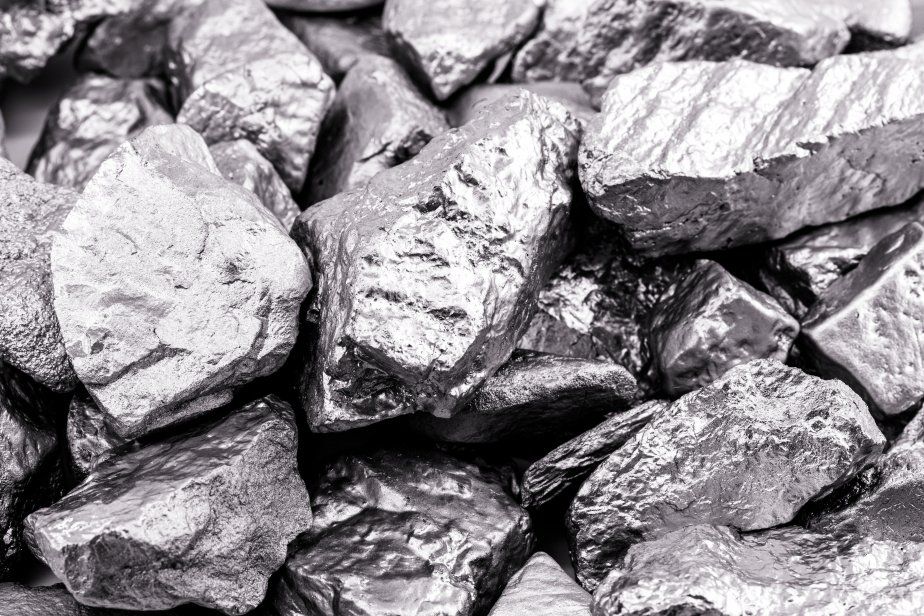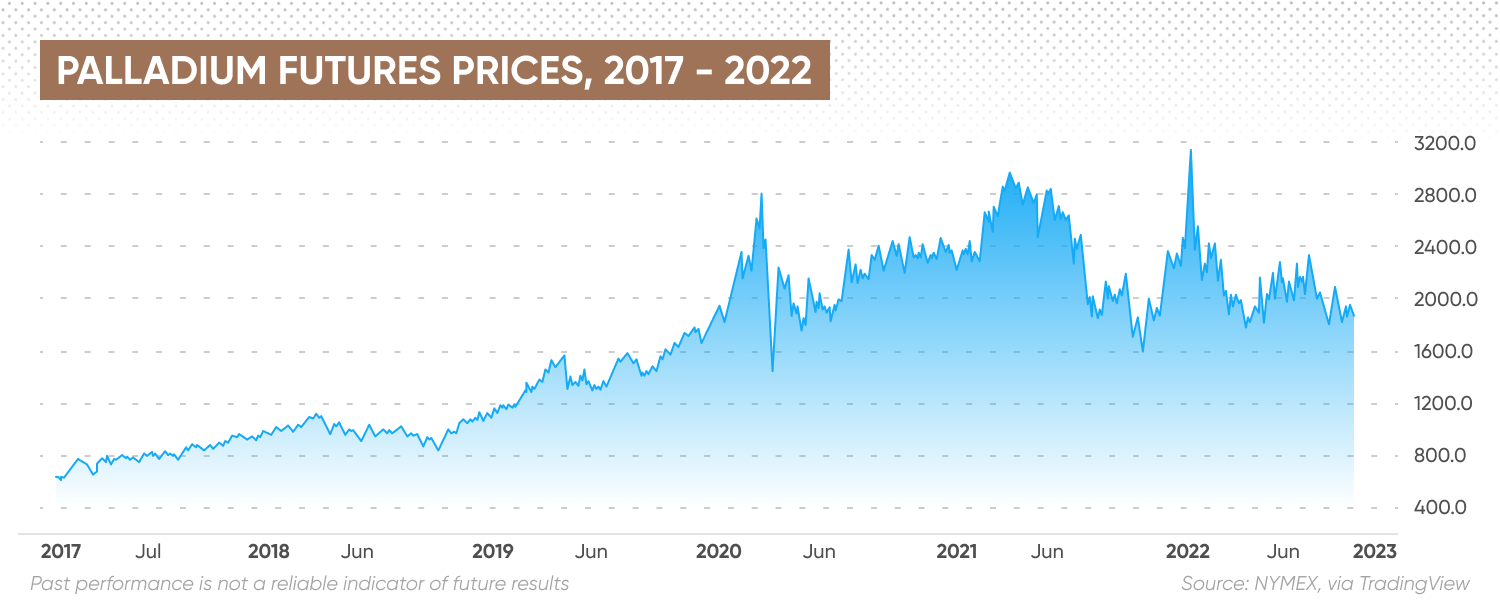Palladium price forecast: Will the precious metal rebound in 2023?
The metal is struggling to regain 2021 highs amid weak automotive demand.
Palladium prices have spiked following the invasion of Ukraine by Russia, the metal’s biggest exporter, yet stabilised further in 2022 as chip shortages and the push for electric vehicles (EVs) depressed automotive demand.
On the supply side, with floods and weather conditions overcome, analysts suggest a palladium surplus in 2023 is possible.
Palladium live price chart
Where next for the precious metal and can it find new use cases amid the growing popularity of EV vehicles? Here we take a look at what factors are shaping the palladium price forecast.
What is palladium?
Palladium is a silvery-white precious metal discovered in Brazil in the 1700s, where it was dubbed “worthless gold”. It was not until 1803 that the metal was finally extracted by English chemist and physicist William Wolaston.
Today palladium can be found in sulphide minerals, such as braggite, and is extracted as a by-product of nickel, copper and zinc. Along with platinum, ruthenium, rhodium, iridium and osmium, palladium is one of the six metals of the platinum group (PGMs). These metals are extremely rare and are valued for their superior catalytic features.
The majority of palladium supply is used for catalytic converters – devices embedded in the exhaust system of fossil fuel-powered cars to neutralise harmful emissions. The rapidly growing popularity of EVs is expected to hurt palladium demand as they do not require catalysts.
The silvery-white metal is also used in electronics, for example, in ceramic capacitors of laptops and phones; in dentistry, for fillings and crowns; and in jewellery as an alternative to platinum.
South Africa, Russia, Canada, the US and Zimbabwe were the biggest palladium producers in 2021, according to data collected by Statista. Meanwhile, the biggest palladium-exporting countries were Russia, South Africa, the US, the UK and Italy. The biggest importers were the UK, the US, Canada, Hong Kong and Switzerland, WITS data showed.
Due to its rarity, palladium is often seen as an investment asset. Traders can speculate on palladium prices through various instruments, including spot palladium trading, futures and options contracts, palladium mining stocks and exchange-traded funds (ETFs), and financial derivatives. Note that all trading contains the risk of making a loss.
Palladium price analysis
As with any commodity, palladium price is primarily shaped by the forces of supply and demand. The palladium spot price rallied in 2020 amid supply deficits caused by pandemic-induced restrictions in exporting countries.
An outage at an Anglo American (AALI) plant in South Africa in 2020 further tightened supply. And in February 2021, flooding at a mine and an accident at a concentrator reduced production at Russia’s Nornickel (Norilsk Nickel) (MNODI), the world’s largest palladium producing company. Palladium futures on New York Mercantile Exchange (NYMEX) reached their 2021 peak of $2,976 per troy ounce (/oz) in May 2021.

In the second half of 2021, however, the global semiconductor chip shortage caused automotive manufacturers worldwide to cut production. This had a knock-on effect on palladium demand, with the futures prices falling to $1604/oz in December 2021.
Although the invasion of Ukraine by Russia pushed palladium prices to an all-time high of $3,146/oz in March 2022, prices quickly stabilised, offset by the US dollar’s strength and an ongoing decline in automotive demand. In the last months of 2022, palladium futures have been hovering around the $1,900/oz mark.
Supply to “shift into surplus” in 2023
In August 2022, Russia-based palladium giant Nornickel said that supply chain disruptions caused by the Western sanctions have reduced its sales for the first half of 2022.
In its second-half report, the company pointed out that supply was expected to grow in 2022, however, “the downside risk remains due to the infrastructure flooding at the Stillwater mine and a potential strike at the Sibanye-Stillwater assets in South Africa”.
Johannesburg-based precious metal producer Sibanye-Stillwater’s mine operations in Montana were hurt by a significant flooding event in June 2022. It forced the firm to cut its output forecast to 445,000-460,000 ounces in 2022, according to the latest half-year report.
In its precious market forecast for 2023, Heraeus Group argued that “primary palladium supply is projected to rebound as mines affected by weather-related incidents this year will be back to normal output and the stock built up by a delayed smelter rebuild in South Africa should be processed in 2023.”
“Secondary supply is expected to be marginally higher, but if economic conditions deteriorate further, automotive recycling could disappoint,” they added.
In a September 2022 note, Bank of America (BofA) expected palladium to “slowly shift into surplus”, with global consumption projected to rise 4.5% in 2023 and global consumption to fall by 5.8%, leaving the metal with a balance of 1.809m ounces.
The surplus was expected to grow to 2,339 ounces in 2024. “Palladium will likely be oversupplied in the medium term,” the bank said.
Automotive demand remains low
In other palladium price news, Nornickel also said that “global automotive market recovery is deferred to 2023” amid a “lack of semiconductors and supply chain interruptions impact vehicle output”. The firm saw automotive production recover in 2023, growing 11% to 89m units alongside improving chip availability.
In their December palladium price outlook, ANZ research analysts pointed out that “easing semiconductor supply tightness could revive auto-sector demand for PGMs”. They added:
The growing popularity of EVs and the push for sustainable energy along with macroeconomic headwinds pose risks to palladium demand from the automotive sector, according to Heraeus Group analysts, who noted:
Palladium price forecast for 2023 and beyond
In their palladium price forecast for 2023, ANZ Research saw the metal trading at $2,048/oz in the year, falling back to $1,805/oz in 2024.
“We see platinum outperforming palladium as demand for the precious metal is boosted from both jewellery and industrial sectors. Further, normalising of the supply chain should see growth in auto catalyst demand,” said ANZ research analysts in a December note.
In September 2022, Bank of America set a 2023 target for the future value of palladium at $1740/oz, noting that “chip shortages cap the upside to prices, but a normalisation of dislocations should ultimately boost demand.”
BofA’s palladium price forecast for 2025 saw the precious metal trading at $1,564 and falling to $1,497/oz in 2026.
Heraeus Group predicted palladium's future price to trade between $2,259/oz and $1,300/oz in 2023, “as the market is moving into surplus which weighs on the price.” The analysts said:
TD Securities spot palladium price predictions saw the metal trading at $1,879/oz in the first quarter of 2023, rising to $2,100/oz by early 2024. In 2025, the firm saw the precious metal falling back to $1,950/oz.
TradingEconomics, meanwhile, as of 15 December, expected palladium to trade at $2,032.00/oz by the end of this quarter. “Looking forward, we estimate it to trade at $2,300.09 in 12 months time,” the website added.
Analysts refrained from providing palladium price forecasts for 2030 due to a number of uncertainties at play.
Palladium price predictions from analysts
|
2023 |
2024 |
2025 |
2026 |
|
|
ANZ Research |
$2,048/oz |
$1,805/oz |
||
|
BofA |
$1740/oz |
$1632/oz |
$1,564 |
$1,497/oz |
|
Heraeus Group |
$1,300/oz - $2,259/oz |
|||
|
TD Securities |
$1,879/oz in Q1 |
$2,100/oz in Q1 |
$1,950/oz |
|
|
Trading Economics |
$2,300.09/oz in Q4 |
Final thoughts
Remember, analysts and algorithm-based predictions can be wrong. Palladium price forecasts shouldn’t be used as a substitute for your own research. Always conduct your own due diligence before trading, looking at the latest news, technical and fundamental analysis, and a wide range of commentary.
Keep in mind that past performance does not guarantee future returns, and never trade money you cannot afford to lose.
FAQs
Is palladium a good investment?
Whether palladium is an appropriate investment for you would depend on your risk tolerance, portfolio composition and strategy, and other personal factors. You should conduct your own due diligence before investing.
Will palladium price go up or down?
In their palladium price forecast for 2023, ANZ Research saw the metal trading at $2,048/oz in the year, falling to $1,805/oz in 2024. Bank of America set a 2023 target for the future value of palladium at $1740/oz, noting that “chip shortages cap the upside to prices, but a normalisation of dislocations should ultimately boost demand”. Haraeus Group predicted palladium future price to trade between $2,259/oz and $1,300/oz in 2023, “as the market is moving into surplus which weight on the price.” Note that analysts’ predictions can be wrong.
What drives palladium prices?
As with any commodity, palladium price is primarily shaped by the forces of supply and demand. The metal is mostly used for catalytic converters – devices embedded in the exhaust system of fossil fuel-powered cars to neutralise harmful emissions. Any change in the automotive sector, such as push for EVs, could affect the palladium price. On the supply side, mine disruptions could restrict supply, boosting the price.